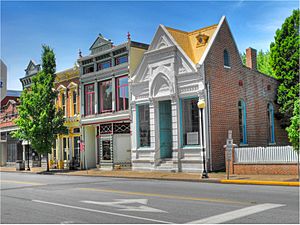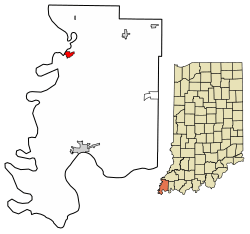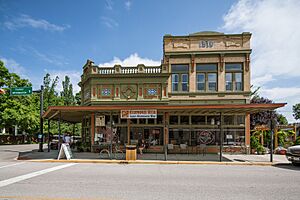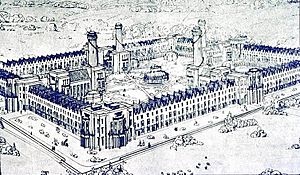New Harmony, Indiana facts for kids
Quick facts for kids
New Harmony, Indiana
|
|
|---|---|
|
Town
|
|

Downtown New Harmony
|
|

Location of New Harmony in Posey County, Indiana.
|
|
| Country | United States |
| State | Indiana |
| County | Posey |
| Township | Harmony |
| Area | |
| • Total | 0.82 sq mi (2.13 km2) |
| • Land | 0.81 sq mi (2.11 km2) |
| • Water | 0.01 sq mi (0.02 km2) |
| Elevation | 377 ft (115 m) |
| Population
(2020)
|
|
| • Total | 690 |
| • Density | 923.93/sq mi (356.82/km2) |
| Time zone | UTC-6 (CST) |
| • Summer (DST) | UTC-5 (CDT) |
| ZIP code |
47631
|
| Area code(s) | 812 |
| FIPS code | 18-52974 |
| GNIS feature ID | 2396802 |
| Website | http://www.newharmony-in.gov |
New Harmony is a historic town in Posey County, Indiana. It sits on the Wabash River. The town had a population of 690 people in 2020.
New Harmony was first founded in 1814 by a group called the Harmony Society. Their leader was George Rapp. They called their settlement Harmony. In 1824, they decided to sell their land and move back to Pennsylvania.
In 1825, a man named Robert Owen bought the town. He was a social reformer from Wales. Owen wanted to create a new kind of community, a "utopian community," where everyone would live and work together equally. He renamed the town New Harmony. However, his big experiment didn't last very long.
Even though Owen's community didn't succeed, New Harmony became famous for its ideas. It helped change American education and scientific research. The town had the first public library and a public school system open to both boys and girls. Many important scientists and educators lived and worked here.
Today, many of the old buildings from the Harmonist and Owenite communities have been fixed up. You can visit them in the New Harmony Historic District. There are also newer buildings like the Roofless Church and the Atheneum.
Contents
A Look Back: New Harmony's Story
The Harmonists' First Home (1814–1824)
The town of Harmony was started in 1814 by a religious group called the Harmonists. Their leader, George Rapp, was a German immigrant. This was the second of three towns built by this group. They were known for living together and sharing everything.
The Harmonists moved to Indiana because their first home in Pennsylvania was getting too crowded. They wanted a quiet place with good land and a river for travel. In April 1814, some Harmonists found the perfect spot along the Wabash River. It was about 15 miles (24 km) from where the Wabash River meets the Ohio River.
The first Harmonists arrived in Indiana in June 1814 by boat. By 1816, the same year Indiana became a state, they had bought 20,000 acres (81 km²) of land. They built 160 homes and other buildings. They also cleared 2,000 acres (8.1 km²) for farming.
Many visitors were amazed by how much work the Harmonists did. They had factories, farms, and even a brewery and winery. One visitor said it felt like being in Germany. The town was well-planned, with a church, school, and homes all laid out neatly.
The Harmonists were very busy. They worked in tanneries, sawmills, and textile mills. They made cloth, yarn, rope, beer, and many other goods. Even though they weren't paid wages, everyone contributed to the community.
By 1824, the Harmonists decided to move again. They wanted to be closer to eastern markets and live with more people who shared their German language. In May 1825, the last Harmonists left Indiana. They sold their entire property, including all the land and buildings, to Robert Owen for $150,000.
Robert Owen's Big Idea (1825–1827)
Robert Owen was a very rich businessman from Scotland. He had made his money from textile factories. Owen believed he could create a "New Moral World" where people would be happy and smart through education, science, and living together. He thought his perfect community would be a model for everyone.
In 1824, Owen came to the United States to find a place for his new community. The ready-built town of Harmony, Indiana, was perfect. In January 1825, he bought the town and renamed it New Harmony. He invited "any and all" to join him.
Many people came, hoping to make the community a success. But some were just looking for a free ride. Owen's son, William, who stayed in New Harmony, worried about this. He wondered if people used to comfortable lives would truly enjoy this new way of living.
When Robert Owen returned in April 1825, he found 700 to 800 people and a lot of confusion. The community adopted a "Constitution of the Preliminary Society." It said members would share their goods and invest money. They would work for the community and get credit at the town store.
Owen left his son William in charge while he traveled to promote New Harmony. Owen's four sons and one daughter later moved to New Harmony.
Why Owen's Plan Didn't Work
Even with good intentions, the community started to have problems. People complained about some members not working as hard as others. The town became too crowded, and there wasn't enough housing. They also struggled to produce enough food and goods to support everyone.
Owen spent only a few months in New Harmony. There weren't enough skilled workers or good managers, which led to its failure.
Despite the problems, Owen was very passionate about his vision. He convinced many smart people to join him. On January 26, 1826, a group of scientists and educators arrived in New Harmony. They came on a boat nicknamed the "Boatload of Knowledge." This group included William Maclure, Marie Louise Duclos Fretageot, Thomas Say, and Charles-Alexandre Lesueur.
On February 5, 1826, the town tried a new plan called "The New Harmony Community of Equality." It aimed for happiness based on equal rights and duties. It talked about cooperation, sharing property, and getting knowledge. It even had rules for how children of different ages would be cared for and educated.
However, this new plan was never fully put into action. Some people believed the community failed because it didn't allow for individual freedom or private property. Owen also upset some people by speaking out against religion.
By March 1827, after many tries to make it work, the utopian experiment failed. The larger community broke into smaller groups, and arguments continued. In 1828, the idea of sharing everything was replaced by individual ownership. Owen spent a lot of his own money to buy back the property and pay off debts. He left New Harmony in June 1827.
New Harmony Today
Where is New Harmony?
New Harmony is in the western part of Indiana. The Wabash River forms its western border.
The town covers about 0.65 square miles (1.68 km²). Most of this is land, with a small amount of water.
Weather in New Harmony
New Harmony has hot, humid summers and mild to cool winters. This type of weather is called a humid subtropical climate.
Who Lives in New Harmony?
| Historical population | |||
|---|---|---|---|
| Census | Pop. | %± | |
| 1850 | 700 | — | |
| 1860 | 825 | 17.9% | |
| 1870 | 836 | 1.3% | |
| 1880 | 1,095 | 31.0% | |
| 1890 | 1,197 | 9.3% | |
| 1900 | 1,341 | 12.0% | |
| 1910 | 1,229 | −8.4% | |
| 1920 | 1,126 | −8.4% | |
| 1930 | 1,022 | −9.2% | |
| 1940 | 1,390 | 36.0% | |
| 1950 | 1,360 | −2.2% | |
| 1960 | 1,121 | −17.6% | |
| 1970 | 971 | −13.4% | |
| 1980 | 945 | −2.7% | |
| 1990 | 846 | −10.5% | |
| 2000 | 916 | 8.3% | |
| 2010 | 789 | −13.9% | |
| 2020 | 690 | −12.5% | |
| U.S. Decennial Census | |||
In 2010, there were 789 people living in New Harmony. Most residents were White (99%).
The average age in town was 55.1 years old. About 13.1% of residents were under 18, and 33.5% were 65 or older.
Learning in New Harmony
New Harmony is part of the Metropolitan School District of North Posey County.
For over 200 years, New Harmony had its own school for all grades. But in 2012, due to fewer students and less money, the school joined with the North Posey County district.
Now, students from New Harmony attend these schools:
- North Posey High School (grades 9–12)
- North Posey Junior High School (grades 7–8)
- North Elementary School (grades K–6)
Getting Around New Harmony
Several state roads serve New Harmony:
 Indiana State Road 66
Indiana State Road 66 Indiana State Road 68
Indiana State Road 68 Indiana State Road 69
Indiana State Road 69
See also
 In Spanish: New Harmony (Indiana) para niños
In Spanish: New Harmony (Indiana) para niños






